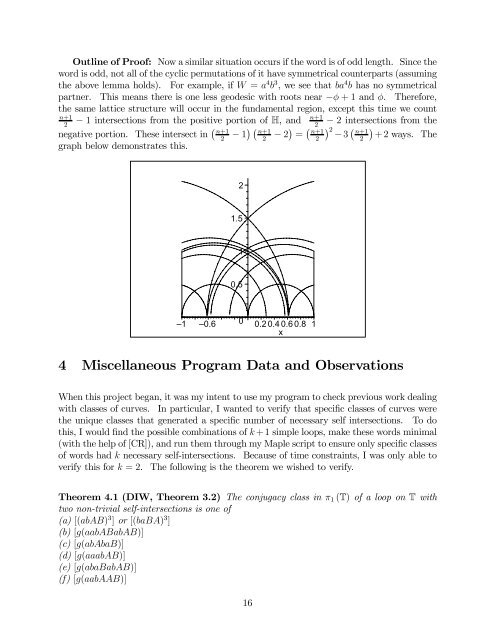The Maximal Number of Transverse Self-Intersections of Geodesics ...
The Maximal Number of Transverse Self-Intersections of Geodesics ...
The Maximal Number of Transverse Self-Intersections of Geodesics ...
Create successful ePaper yourself
Turn your PDF publications into a flip-book with our unique Google optimized e-Paper software.
Outline <strong>of</strong> Pro<strong>of</strong>: Now a similar situation occurs if the word is <strong>of</strong> odd length. Since the<br />
word is odd, not all <strong>of</strong> the cyclic permutations <strong>of</strong> it have symmetrical counterparts (assuming<br />
the above lemma holds). For example, if W = a 4 b 3 ,weseethatba 4 b has no symmetrical<br />
partner. This means there is one less geodesic with roots near −φ +1and φ. <strong>The</strong>refore,<br />
the same lattice structure will occur in the fundamental region, except this time we count<br />
n+1<br />
− 1 intersections from the positive portion <strong>of</strong> H, and n+1 − 2 intersections from the<br />
2 2<br />
negative portion. <strong>The</strong>se intersect in ¡ n+1<br />
− 1 ¢¡ n+1<br />
− 2 ¢ = ¡ ¢<br />
n+1 2<br />
− 3 ¡ ¢<br />
n+1<br />
2 2 2<br />
2 +2 ways. <strong>The</strong><br />
graph below demonstrates this.<br />
2<br />
1.5<br />
1<br />
0.5<br />
–1 –0.6 0 0.2 0.4 0.6 0.8 1<br />
x<br />
4 Miscellaneous Program Data and Observations<br />
When this project began, it was my intent to use my program to check previous work dealing<br />
with classes <strong>of</strong> curves. In particular, I wanted to verify that specific classes <strong>of</strong> curves were<br />
the unique classes that generated a specific number <strong>of</strong> necessary self intersections. To do<br />
this, I would find the possible combinations <strong>of</strong> k +1 simple loops, make these words minimal<br />
(with the help <strong>of</strong> [CR]), and run them through my Maple script to ensure only specific classes<br />
<strong>of</strong> words had k necessary self-intersections. Because <strong>of</strong> time constraints, I was only able to<br />
verify this for k =2. <strong>The</strong> following is the theorem we wished to verify.<br />
<strong>The</strong>orem 4.1 (DIW, <strong>The</strong>orem 3.2) <strong>The</strong> conjugacy class in π 1 (T) <strong>of</strong>alooponT with<br />
two non-trivial self-intersections is one <strong>of</strong><br />
(a) [(abAB) 3 ] or [(baBA) 3 ]<br />
(b) [g(aabABabAB)]<br />
(c) [g(abAbaB)]<br />
(d) [g(aaabAB)]<br />
(e) [g(abaBabAB)]<br />
(f) [g(aabAAB)]<br />
16

















